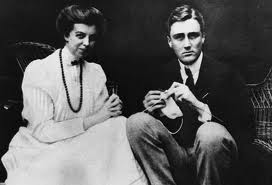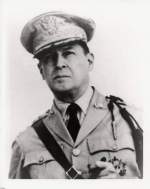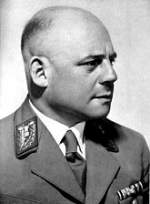
1834 Birth: Auto pioneer Gottlieb Daimler:
As a teenager, Daimler apprenticed to become a gunsmith and later moved into mechanical engineering. In 1885, he met Wilhelm Maybach (1846-1929) and the two developed a new, efficient version of the four-stroke engine internal-combustion engine. (Nikolaus Otto is credited with inventing the first functioning four-stroke engine.) Daimler and Maybach attached their engine to a wooden bicycle, creating what has been referred to as the world's first motorcycle. In 1886, they fit their engine to a carriage, creating a four-wheel, motorized vehicle. In 1890, Daimler founded the Daimler Motoren Gesellschaft company, with Maybach serving as technical director. The company built automobiles and engines for a variety of vehicles.
Gottlieb Daimler died at the age of 65 on March 6, 1900. Later that year, the first Mercedes automobile, designed by Wilhelm Maybach, was delivered to entrepreneur and car dealer Emil Jellinek. The vehicle was named for Jellinek's daughter Mercedes. [For further details, Click here.]
1898 Submarine: The first practical submarine made by John Holland is submerged off Staten Island, New York and remains underwater for a little longer than an hour (100 minutes). Holland's sub was not the first underwater boat, but is credited as the first practical one. Holland:
I first interred in contests for a submarine, provided by the US Navy in 1888. I won but they never built the sub. There were many contests much like that one that took place. I won all of them but they never built my subs. I became very discouraged by this and turned back to the problems of "mechanical flight." I couldn't find anyone to back my designs. I took a position for Morris and Cummings Dredging Company. I worked for Charles Morris until 1893. On March 3, 1893 Congress appropriated 200,000 to cover another competition for a submarine torpedo boat. Elihu Frost and been thinking about forming a company to provide me with money to continue my submarine experiments. Frost felt the time was right and agreed to loan me the money I needed to prepare a bid. That spring the Holland Torpedo Boat Company was formed. Frost was secretary treasurer and I was a manager with a salary of $50,000 per month. I got a contract to build a submarine according to Navy specifications. They gave me $150,000. It was a long time before the US Navy gave me all the money I needed to build them a submarine, but over time I got it all.
1905 Franklin Roosevelt marries Eleanor Roosevelt:

Future president Franklin Delano Roosevelt weds his fifth cousin once removed, Eleanor Roosevelt, in New York on this day in 1905.
Eleanor, born Anna Eleanor Roosevelt in New York in 1884, lost her mother Anna to diphtheria when she was eight. Her father, Elliot, a brother of Theodore Roosevelt, died as a result of alcoholism when she was 10 years old. As a result, Eleanor was raised by the extended Roosevelt family and met her future husband for the first time when she was just two years old and he was four. They saw each other frequently at dances and parties and over the years became very close. In 1903, a 22-year-old Franklin proposed marriage to the 19-year-old Eleanor; the couple wed two years later on St. Patrick's Day. Former President Theodore Roosevelt gave away the bride. As Franklin pursued a career in politics, Eleanor raised four children (a fifth died in infancy), volunteered in civic organizations and worked for women's suffrage before becoming first lady.
A year after their wedding, Teddy Roosevelt, who was very fond of his niece, wrote to FDR, "you and Eleanor are true and brave, and I believe you love each other unselfishly..." However, their married life proved less than blissful. In 1918, Eleanor was devastated to discover that Franklin was having an affair with her secretary, Lucy Mercer. When Eleanor threatened to leave him, his mother intervened and offered to support Eleanor financially if she would stay in the marriage. After that, Eleanor and Franklin maintained the public facade of a married couple but in reality lived as platonic partners who shared an interest in public service.
When Roosevelt became president in 1933, the shy Eleanor blossomed as she made public appearances on behalf of her husband and pursued a variety of philanthropic activities. She used her celebrity to promote civil rights and humanitarian causes and also published a daily newspaper column called "My Day." Roosevelt valued Eleanor's intellect and viewpoint and often consulted her on presidential matters.
FDR continued to have other affairs, including one with his secretary, Missy LeHand. His son, Elliot, recalled having seen LeHand sitting on his father's lap and, that he, like the rest of the president's family, "accepted it as a matter of course." As for Eleanor, unsubstantiated rumors flourished regarding her alleged lesbian love affair with a female reporter named Lorena Hickok. The two women exchanged letters brimming with sexual undertones. A dear friend and mentor to Eleanor, Hickok moved into the White House in 1940.
After FDR's death in 1945, Eleanor stayed active in public service, becoming a delegate to the United Nations General Assembly in 1948. She died in 1962. (History.com)
1914 World War I: Russia: Number of active duty military increased from 460,000 to 1,700,000.
1915 Death: Four French Corporals for cowardice: (for refusing to advance out of their trenches through the carnage of a World War I No Man's Land):
It was not only Corporals Theophile Maupas, Louis Lefoulon, Louis Girard and Lucien Lechat who had refused. The entire 21st Company of the 336th Infantry regiment, exhausted and already decimated by combat, was ordered over the trench at dawn on March 10. Under withering machine gun fire, and with French artillery carelessly dropping shells just in front of their own lines, the 21st stayed put. Frantic to force the advance, the French commander ordered artillery to drive the troops ahead by shelling his own trenches: an order the artillerists refused to carry out unless someone put it in writing.
In that slaughterhouse of trench warfare, insubordination in the ranks met stern reprisals. Generals with no strategy but to make mincemeat of their countrymen could not well abide the meat's reluctance to be minced. Examples must be made, especially inasmuch as the impracticality of executing entire companies impressed even the brass.
On March 16, six corporals and 18 soldiers of the intransigent company faced military trial in the Suippes town hall; the four condemned were shot the next day and buried under dishonorable black crosses.
According to "Shot At Dawn", a campaign for rehabilitating soldiers executed during World War I, France carried out some 600 military executions during those bloody years, more than any other country. A 1999 study numbered 550 French executions. In an essay in Handbook on Death and Dying, Prof. J. Robert Lilly suggests that many more "unofficial" executions may have taken place, especially during the war's panicked opening stages.
Whatever their precise number, the shootings, around Europe, of hundreds of men for cowardice‑-most in obscurity, many chosen arbitrarily, some whose descendants still struggle for recognition to this day‑-is one of the enduring legacies of World War I: the collision of that most individual penalty with that most faceless and indiscriminate war.
1916 World War I: Gefreiter Adolf Hitler endures trench warfare in Flanders (Artois) with 3 Company, 16 Reserve Infantry Regiment [List Regiment]. [For further details, Click here.]
1917 World War I: Shakeup in French government:
In the midst of Allied plans for a major spring offensive on the Western Front, the French government suffers a series of crises in its leadership, including the forced resignation, on March 17, 1917, of Prime Minister Aristide Briand. [For further details, Click here.]
1920 Weimar: Kapp Putsch: The putsch fails after only four days and Kapp flees Berlin. Hitler and Eckart arrive in Berlin too late to take part.
The KPD had grown from 3-4000 members in January 1919 to 78,000 immediately after the Kapp putsch, despite an ultra-left split-off. It was nevertheless tiny in comparison to the two other mass parties, which had approaching one million members apiece. Under the impact of events, however, the ranks of the USPD was moving away from reformism and towards the ideas of Marxism.
1921 Poland: March Constitution adopted by the Second Republic, after ousting the occupation of the German/Prussian forces in the 1918 Greater Poland Uprising, and avoiding conquest by the Soviets in the 1920 Polish-Soviet War. When the borders of the state were fixed in 1921, it had an area of 388.6 thousand sq. km. (sixth largest in Europe), and 27.2 million inhabitants according to the census of that year. In 1939, just before the outbreak of World War II, it had an estimated 35.1 million inhabitants. A third of these were national minorities; 17% Ukrainians and Belarusians, 10% Jews, 5% Germans, and 1% percent Lithuanians, Russians, and Czechs.
1926 Weimar: League of Nations Spain and Brazil prevent Germany from joining.
1927 League of Nations: US government refuses to sign the disarmament treaty.
1929 Weimar: Adam Opel General Motors acquires the German auto manufacturer, which continues as a subsidiary.

1931 USSR: Krupskaya Lenin: Joseph Stalin expels the Soviet founder's widow from the Central Committee. [See: Worst Dictator of Modern Times: Hitler or Stalin?]
1932 Weimar: Nazi Party German police raid Hitler's headquarters.
1933 Nazi Germany: Various: Schutzstaffel (SS):
Holocaust: Poland protests the mistreatment of Polish Jews in Germany.
1938 From an address delivered by US Secretary of State Hull:
In connection with the Far Eastern situation, this Government was confronted with the question of applying the existing neutrality legislation, which was designed primarily to keep our Nation out of war. After mature deliberation the conclusion was reached that in the circumstances attending the controversy in the Far East—a type of circumstances which the authors of the legislation could scarcely have visualized—application of the law would be most likely to endanger the very objectives which the law was designed to promote. Accordingly, exercising the discretion vested in him by the law itself, the President has refrained from putting the provisions of that law into operation. [For the full text, Click here.]
1939 Sino-Japanese War (1937-1945): Battle of Nanchang between the Kuomintang and the Japanese breaks out.
1940 World War II: Fritz Todt named Reich Minister for Weapons and Munitions:
Dr. Todt, an engineer and master road builder, is appointed Minister for Weapons and Munitions, ushering in a new era in the efficient use of German industry and forced labor.
A civil engineer with a doctorate from the School for Advanced Technical Studies in Munich, Fritz Todt caught the attention of Adolf Hitler in 1932 as Todt spoke out about the importance of building new roads to jumpstart a moribund German economy. Once Hitler came to power, Hitler placed Todt in charge of a massive road-building project that remains remarkable today: the Autobahn, Germany's superhighway.
Todt designed the Autobahn so it would "harmonize with the German landscape." One of the unintentional outcomes of the project was that it provided a working model of the use of slave labor within the Nazi regime. In February 1940, realizing that mass executions in occupied Poland were not serving the Reich efficiently, Hitler decided to create a centralized and supervised source of mass slave labor. It was Todt who was chosen to command the project. The Todt Organization became the single largest employer of slave labor in Hitler's empire, disseminating workers to shorthanded munitions plants. And as Minister for Munitions and Weapons, Todt oversaw a more efficient use of raw materials in Hitler's arms machine.
Todt's engineering skills also proved useful in the war against France, with the design and construction of what was called the "West Wall," a fortress line of bunkers that divided the Franco-German border. (History.com)
1941 Various: Holocaust: Hans Frank meets with Hitler in his private rooms in the Reich Chancellery:
Death: Joachim Schepke German commandant of U-100, in battle:
U-100 was sunk southeast of Iceland after being rammed and depth charged by the British destroyers HMS Walker and HMS Vanoc. Vanoc spotted U-100 with her early radar in heavy fog and chased the contact. Thirty-eight men were killed, including Schepke, who is said to have been caught on the bridge when the boat was rammed. Six crew members survived.
1942 Various: World War II: General Douglas MacArthur
Holocaust: Beginning of "Aktion Reinhard": (Operation Reinhard). Jews from Lublin are transported to Belzec. (THP)
Holocaust: Ilja: Two Jewish leaders, who had refused to hand over partisan sympathizers to the SS, escape into the forest to join the partisans. As a reprisal, the Germans shoot all old and sick Jews they find in the streets, and force 900 more into a building, lock it, and set it on fire. All 900 perish. (THP)
Holocaust: Belzec: A second death camp goes into operation just south of the village of Belzec in Galicia. 6,786 Jews are murdered during the first set of deportations. (total victims: 600,000; survivors: 2) Two other death camps, Sobibor and Treblinka are now under construction. These are not slave labor camps; their single purpose is to kill every Jew within a few hours of arrival. (THP) [See: Jewish War Heroes.]
1943 Various: World War II: Sauckel to Rosenberg:
After a protracted illness, my deputy for labor allocation in the Occupied Eastern Territories, State Councilor Peuckert, is going there to regulate the allocation of labor both for Germany and the territories themselves. I ask you sincerely, dear Party Member Rosenberg, to assist him to your utmost on account of the pressing urgency of Peuckert's mission. I may thank you already at this moment for the good reception accorded to Peuckert up to this time. He himself has been charged by me to co-operate fully and unreservedly with all bureaus of the EasternTerritories. Especially the labor allocation for German agriculture and likewise the most urgent armament production programs ordered by the Fuehrer, make the fastest importation of approximately 1 million men and women from the Eastern Territories within the next 4 months, a necessity. Starting 15 March the daily shipment must reach 5,000 female or male workers, while from the beginning of April this number has to be stepped up to 10,000, if the most urgent programs and the spring tillage and other agricultural tasks are not to suffer to the detriment of the food and of the Armed Forces. I have provided for the allotment of the draft quotas for the individual territories, in agreement with your experts for labor supply, as follows: Daily quota starting 15 March 1943: From General Kommissariat, White Ruthenia - 500 people: Economic Inspection, Center- 500 people; Reichskommissariat, Ukraine-3,000 people; Economic Inspection, South-1,000 people; total-5,000 people. Starting 1 April 1943, the daily quota is to be doubled corresponding to the doubling of the entire quota. I hope to visit personally the Eastern Territories towards the end of the month, and ask you once more for your kind support.
Holocaust: Mischlings: Hofmann, head of the RuSHA, submits a proposal to Himmler for the "final solution" of the question of part-Jews prepared by his subordinate Professor B. K. Schultz:
It is proposed that: quarter-Jews should not be included in the same category as persons of German blood without exception, but that they should first undergo a racial classification. Every quarter-Jew in whom Jewish racial characteristics are clearly prominent, as judged from external appearances, should be treated in the same way as half-Jews (i.e. as Jews). (THP) [See: What Was the Nature of Hitler's Anti-Semitism?]
Holocaust: Bulgaria: Parliament votes unanimously against the deportation of Bulgarian Jews, and none are deported to gas chambers from Bulgaria itself. The country's Jewish population actually increased during the war, from 48,565 in 1934 to 49,172 in 1945. (THP)
1945 World War II: Various: War in the Pacific:

Churchill to General Ismay:

I should like the Intelligence Committee to consider the possibility that Hitler, after losing Berlin and Northern Germany, will retire to the mountainous and wooded parts of Southern Germany and endeavor to prolong the fight there. The strange resistance he made at Budapest and is now making at Lake Balaton, and the retention of Kesselring's army in Italy so long, seem in harmony with such an intention. But of course he is so foolishly obstinate about everything that there may be no meaning behind these moves. Nevertheless the possibilities should be examined. [See: Why Did Hitler Insist on No Surrender?]
1990 Lithuania rejects Soviet demand to renounce its independence:
The former Soviet Socialist Republic of Lithuania steadfastly rejects a demand from the Soviet Union that it renounce its declaration of independence. The situation in Lithuania quickly became a sore spot in U.S.-Soviet relations. [For further details, Click here.]
Edited by Levi Bookin (Copy editor) Click to join 3rdReichStudies FAIR USE NOTICE: This site may contain copyrighted material the use of which has not always been specifically authorized by the copyright owner. We are making such material available in our efforts to advance understanding of historical, political, human rights, economic, democracy, scientific, environmental, and social justice issues, etc. We believe this constitutes a 'fair use' of any such copyrighted material as provided for in section 107 of the US Copyright Law. In accordance with Title 17 U.S.C. Section 107, the material on this site is distributed without profit to those who have expressed a prior interest in receiving the included information for research and educational purposes. If you wish to use copyrighted material from this site for purposes of your own that go beyond 'fair use', you must obtain permission from the copyright owner. Please note that the list-owner and the moderator are not responsible for, and do not necessarily approve of, the random ads placed on our pages by our web server. They are, unfortunately, the price one pays for a 'free' website.
levi.bookin@gmail.com







